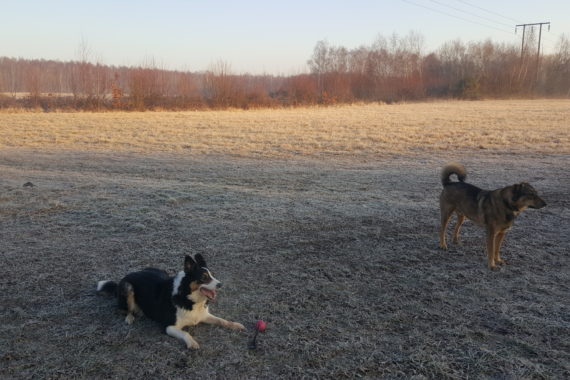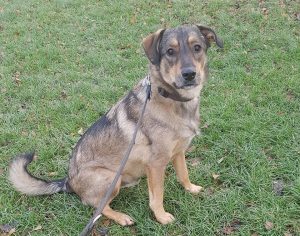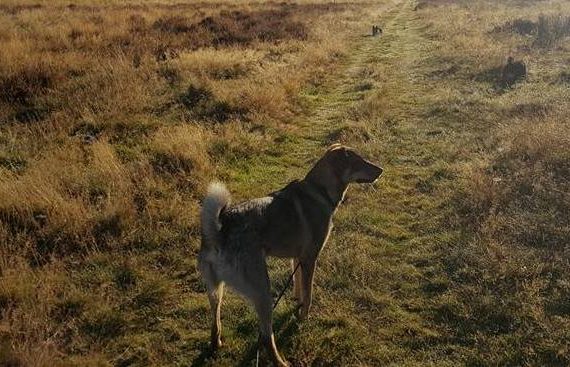What I Do… and the problem with ‘Shoulds’
when Teaching Dogs

As I was out walking my dogs this morning, quite a few things were running through my mind (as is usually the case!) and I decided it was something worth sharing with you. I’ve seen quite a lot of comments lately and been asked similar questions relating to the kind of things I was experiencing this morning, and I wanted to highlight how teaching dogs is not about training sessions, it’s about integrating training into everyday life, so I thought I would give you a blow by blow account of what I do, in case it may help you with your four pawed buddies.
Let me just point out that I don’t have what I would class as a reactive dog, BUT he can be reactive at times. Now there are a couple of reasons for this, so I will go through them first then tell you about our walk this morning, and how I handled it.
STRESS STACKING (Also known as trigger stacking)
This is being talked about quite a lot in doggie circles at the moment, and with good reason. It’s something that can have a huge impact on your dogs behaviour, but many pet dog guardians are unaware of it, or unaware of the significance it has. Now as I mentioned, I wouldn’t class my dog as a reactive dog, but there can be times when I know the likelihood of him reacting to something will be much higher, because of events that may have happened over the previous day, few days or even few weeks.
The thing with stress stacking, is that if you aren’t aware of it, and therefore do nothing to deal with it, then that stress can become cumulative over time.
OVER AROUSAL
A lot of dogs can become over aroused in certain situations, especially when on lead. The expression of this over arousal is very similar to, and can be described as ‘reactivity’ to a trigger situation.
For example, my Romanian Rescue dog gets over aroused when he sees a cat on the street, and given a certain set of circumstances can erupt into barking, lunging and generally looking like a crazy beast! So I have done a lot of work with him on this behaviour, by exposing him repeatedly to controlled situations with lots of cats, and having him able to sit on a yard with 3 or 4 cats wandering around him, with no reaction at all. The thing is, although this training has lessened his reaction in these circumstances, and enabled me to get him to refocus on me a lot quicker, it has not transferred completely to the ‘surprise’ cats we see on street walks, and this is where teaching dogs is simply not a linear line of progress, there are lots of variables to take into consideration, not all of them obvious.
IT’S ABOUT KNOWING YOUR DOG
This may seem pretty obvious, and a lot of guardians will say they know their dog very well, but equally as many have been shocked when I tell them their dog worries about this, or is upset by that, or feels uncomfortable in that situation, they admit, they did not realise this.
 MY WALK THIS MORNING
MY WALK THIS MORNING
So back to the original reason I decide to write this article. I wanted to share with you a step by step account of my walk this morning, so you can read how I deal with ‘possible problems’ and handle real life situations as a result.
So, the first thing, as we left the front of the house to go on a street walk, we had barely walked 30 feet when a cat darted out from under a parked car in front of us. Now this sent Tramp into instant over arousal, excited barking, pulling on the lead and disengaged from me. Let me just add in here, that Tramp has had a lot of experiences in our cul-de-sac that have either stressed him out or over aroused him, so it’s a place that puts him automatically on high alert, cats, children suddenly appearing on bicycles, loose dogs running around etc. It is an everyday situation that will raise his stress levels.
I was able to regain his focus quite quickly, and used the cat situation to do some training work on this trigger. We moved backwards away from the cat using lead release and lead stroking to encourage him to relax and move with me and a ‘Let’s Go’ Cue. The cat continued to sit under the parked car looking at him, but he had returned to being calm and engaged with me, although keeping one eye on the cat! Using focus foundation work, and food rewards he was able to stay calm and simply watch when the cat finally decided to wander off, once it had determined Tramp wasn’t going to chase him.
So as we then continued out of the cul-de-sac, I continued to maintain engagement with Tramp using focus foundation work and by changing my pace to a happy skipping like movement, to encourage him to release the tension from the over arousal he had just experienced. I do this because I know, if he continues to carry that tension with him, the chances of him being reactive on our walk are increased.
As we continue our walk along the main road, we begin to approach a field where there are horses which Tramp used to react to. Now, although I have done desensitisation work with him in this location, he always begins to pull on the lead slightly as we approach this spot, which is a signal to me that he still gets a little anxious about passing the field. So because I know this, I get ahead of the problem.
Around 50ft before the field, I will again increase engagement with him, elicit check ins which I reward with food treats, get his focus back on me by stopping and interrupting the lead pressure he is creating, again using lead release and lead stroking, so that as we pass the field, he is in a more relaxed state. This means, he is able to walk past calmly but he always looks at the horses then checks in with me for reassurance, which I always praise and reward him for.
If I didn’t do this, the chances of him reacting every time we pass that field with horses in would be greatly increased, and of course, because this is a static trigger situation, the more times he does this, the stronger his habitual response would become. By preventing it from happening, I am not only helping Tramp to feel more comfortable about this situation, but I am also preventing the habit of reaction developing.
Once past the horse field, he goes back to sniffing and enjoying all the information he is gathering. As we near a more built up area with houses, we walk past a house where a lady was coming out of her front door with 2 dogs on leads. As we came into view, they erupted into barking and lunging at us. Now Tramp doesn’t like being barked at, and who could blame him. If someone shouted at me every time I walked past, I would be inclined to shout back too! So it’s an understandable response, but again, it’s a situation he needs to learn to cope with, and I would rather he didn’t develop the habit of barking back and getting in a ‘state’.
So once again, I bring out my skipping and ‘Let’s go’ cue which immediately creates a response from Tramp that I am moving him on from this situation, and he happily trots into skipping mode with me. As soon as we’re past the barking dogs, I take a moment to settle him because he was whining, another stress signal – I’m sure if he could talk it would have been something along the lines of ‘Muuuum those dogs shouted at me, did you see!’ :). We engage for a few minutes, have some fun doing high fives, kisses and paw for treats, and he relaxes and returns to sniffing.
Now because we’ve had a few encounters, I am aware that Tramps baseline stress level has been raised. He is fine, and calm, but has now started to want to play with Sky while they’re both on lead, which is something he does to help release tension. So I know these experiences have increased the likelihood of him being over aroused or reactive as we continue our walk.
So I decide to change my route back, to avoid a couple of static triggers that I know we would pass if I didn’t (dog’s barking at gateways if they’re in the garden etc) We see another cat shoot across the road some way ahead, and although Tramp starts to shoot forward, he stops when I signal, and doesn’t bark, which is great, so I praise him massively and we have a little treat party!
As we’re returning along the main road traffic is coming towards us on our side, and Tramp is on my left, closest to the road. I see up ahead there is a cyclist coming, and although Tramp wouldn’t normally react to this I know he’s had quite a few upsets this morning, so again, I’m not going to wait and see if anything happens, I’m going to get ahead of the problem just in case.
So I immediately ask for ‘over’ which we normally use when walking on country lanes if traffic is coming, and it’s a signal to my dogs to hop up on the verge and wait. So we move over, about 5 or 6ft away from the curb, and I request a sit and get Tramp engaged with me. He does take a look at the cyclist, but because we are already engaged, he chooses to remain sitting calmly and look back to me, instead of taking a fancy to the passing bike, which because of his heightened state of arousal, could have elicited a playful pounce from him. I praise him massively for choosing to remain engaged with me, we have another treat party and go on our way.
As we return to the cul-de-sac, I’m again all ready with treats, I know he’s going to go into that cul-de-sac on high alert for the cat he saw earlier, so I again increase engagement with him, elicit check ins which I reward with food treats, get his focus back on me by stopping and interrupting the lead pressure he is creating, again using lead release and stroking. He walks calmly back into our street, albeit having a look round for that cat!

SO WHAT ABOUT THAT WORD ‘SHOULD!’
The thing is, and I come across this quite a bit with clients, I could quite easily feel like, after 18 months of daily training on walks with Tramp, repetition of exercises, monitoring of stress levels, adjusting daily routines, walks and activities as necessary, that my boy SHOULD have all this down by now?
I could quite easily feel like…
He SHOULD be fine when he sees a cat on the street
He SHOULD be fine when a dog barks at him from a gateway
He SHOULD be fine when we walk past a field of horses
He SHOULD be fine when a cyclist comes past
He SHOULD be fine walking back into our cul-de-sac!
The fact is, that MOST of the time these days, he is fine with all of these things, but that doesn’t mean they don’t affect him at all.
He still gets upset when a dog barks at him, he doesn’t react, but I know it upsets him and he needs my reassurance, instantly! He is fine to walk past a field of horses now, but I know he ‘worries’ about it, and will instantly look to me for reassurance. He is fine with most cyclists coming past him now, but I know that if he’s had several other triggers during a walk, it could cause him to have a reaction to the fast moving cyclist that is whizzing past him just a foot or two away.
On a good day he will walk back into our cul-de-sac and be fine, but sometimes because of the history of that environment, he will start to get upset before anything has even happened, so I know, I have to be ready for that and be ahead of the problem.
That fact that I think HE SHOULD BE OK with all these things by now, is completely irrelevant, he’s not, and that’s it in a nutshell. I have to accept and acknowledge that he struggles with these things sometimes, and I have to make sure I’m ready to help him, whenever he needs me, instantly. By doing that, I can prevent a full on meltdown, which is exactly what leads to learned & habitual reactivity, excessive trigger stacking (which also leads to more reactivity) and a constantly over aroused or anxious dog who is not enjoying life to the fullest.
There are lots of instances where that word ‘SHOULD’ can come into play, both with our dogs and with the people in our lives, and I learnt a long time ago to try to become more aware of when that word pops up in my head, or in a sentence, because by becoming aware of it, I am able to question it. I am able to ask myself …. really? Why ‘should’ they? ….and by doing that, it helps me be more understanding, more compassionate and a much better person, teacher and trainer, both to humans & canines.
If any of that sounds familiar to you, or as you read through the tale of my morning walk and think to yourself ‘Jeez, that sounds like a hell of a lot of work’ it kinda is, but also at the same time it kinda isn’t. You see it’s all about learning, practising & developing YOUR habits so they come naturally to you, I often don’t even realise what I’m doing because it is now a well embedded behaviour in my muscle memory, and because of that I am helping Tramp to develop these well embedded behaviours in his muscle memory.
It’s also about knowing your dog, being present and aware enough to read signals and body language, and knowing how to respond calmly and confidently, rather than reacting AFTER something has happened. If you walk along in your own little world, or on your phone, or disengaged from your dog, then guess what, they will be disengaged from you. You will miss important signals and opportunities to prevent problems and reactions from happening, meaning teaching your dog to be more comfortable with all these experiences, will take much longer to achieve.
If you have a reactive dog you’re struggling with, it can be a very distressing and frustrating situation on a daily basis. I have lots of courses, workshops & programs, both free and available to purchase, specifically created for Romanian and overseas dogs and you can find all the details of these over on The DOG’s Point of View Resources website HERE
Please feel free to share this article with anyone you know may find it helpful
Sheelagh Heron
Michelle
Sue Stevenson
Michelle